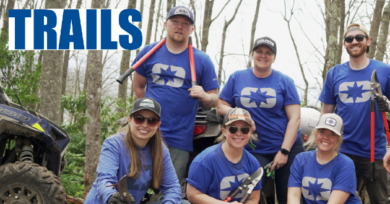August 13, 2007 – ATV Digest
Change in Leadership at DWT
Douglas Henline, founder of Douglas Technologies Group, owner of the DWT wheel brand, has named Paet Hidalgo as his company’s new CEO.
Hidalgo has been leading the California-based company’s marketing and re-branding efforts as a contracted consultant for the past 18 months. He also has extensive auto racing and action sports experience and is a veteran of the Toyota Atlantic, SCCA Trans Am, Formula 3000 series and is currently a licensed IndyCar driver.
“My first objective is to continue efforts to improve our competitiveness in the market place through branding of our products,” Hidalgo said. “I am systematically restructuring how we do business as a company, with an eye on being more efficient and responsive to the needs of our customers.”
Henline was at the helm of DWT, formerly Douglas Wheel, since the company’s beginning in 1991.
OHV Forest Impact Study Features Rare Partnership
This summer U.S. Forest Service employees on the Shasta-Trinity National Forest are working in conjunction with the University of Washington Center for Conservation Biology and the BlueRibbon Coalition in a wildlife study that is the first of its kind.
The study focuses on the potential effects of off-highway vehicles on the federally threatened northern spotted owl, a subject in which there is currently little scientific data. While the study alone is quite notable, the unusual collaboration between the diverse groups makes this project noteworthy.
“This is one of the first times an OHV community has solidly partnered with academia on such a scale,” said BlueRibbon Coalition Western Representative Don Amador. “This project is laying the foundation for great partnerships between these types of groups.”
The groups include the Shasta National Forest, University of Washington Center for Conservation Biology, U.S. Fish and Wildlife, the BlueRibbon Coalition, California Parks and Recreation and the Redding Dirt Riders. The study is being conducted in the Shasta-Trinity National Forest this summer and researchers and interns are living in barracks at the Hayfork Ranger Station.
“The Shasta-Trinity is part of the heart of these owls’ habitat,” said Forest Service Wildlife Biologist Paula Crumpton. “The results from the study will help wildlife biologists implement sound management principles where there is similar owl habitat.”
Maine, Canada Planning International Trail System
With more than 300 miles of existing ATV trails, Maine’s Jackman Moose River Region is looking to takes its network across international boundaries into Quebec.
Now, thanks to the efforts of the Jackman Border Riders Club, the Quebec ATV club and area landowners, riders can cross the border into Canada to explore additional miles of trails in Quebec.
“ATVers account for a large percentage of visitors to the Jackman Maine Moose River Region every year and we expect connecting these two trail systems will attract even more visitors to the area,” said Ray Levesque, president of the Jackman Moose River Region Chamber of Commerce.
After working together for three years, the two clubs celebrated the completion of the Canadian ATV trail to the Jackman Maine border July 21 with an ATV Rendezvous.
“This will put Jackman Maine’s ATV trails on the map as it brings a unique ATV riding experience of a multi-country ride,” said Dave Jones, trail master of the Jackman Maine Border Riders Club.
Riders planning to ride into Canada must obtain a pass to ride on the Canadian ATV trail before crossing the border and must have a valid driver’s license, proof of insurance, registration, helmet and all ATVs must have a mirror. Dirt bikes are not permitted on Canada’s ATV trails.
Arkansas Group Trying to Connect Series of Small Trails
Arkansas’ National Forest Service is working with California-based Trails Unlimited to connect a network of smaller trails in the north central part of the state.
The Sylamore Ranger District hopes to raise $30,000 to rejoin a network of trails that was left disconnected in the wake of trail closures from last year’s route designation process.
Chris Furr, a natural resource specialist at the Sylamore Ranger District, said the area’s hilly topography has made it challenging to connect the existing trails, which primarily lie at the top of ridges. Trails Unlimited will examine topography and recommend possible routes to create a continuous trail corridor.
“We’re just trying to do it right from the start here,” Furr said. “We’re going to be looking at some of the existing roads and trying to give people more of an experience.” psb




